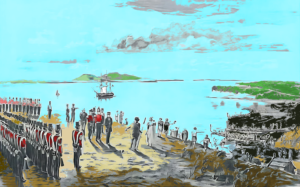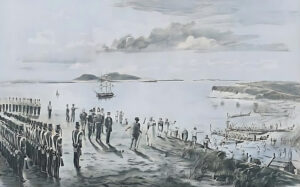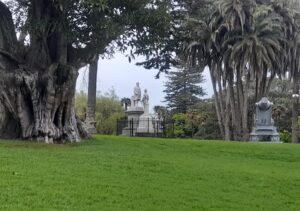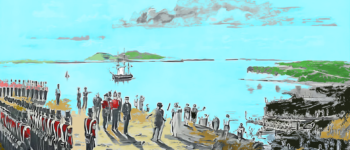1851: The Ngatipaoa Invasion of Auckland
April 17, 2023
By AHNZ
 New Zealand’s capital city, Auckland, was attacked by an invading confederation of some 300 Maori tribesmen of the Hauraki Gulf today in history, 17 April, 1851. A fleet of war canoes established a beachhead at Mechanics Bay where the Port of Auckland now stands.
New Zealand’s capital city, Auckland, was attacked by an invading confederation of some 300 Maori tribesmen of the Hauraki Gulf today in history, 17 April, 1851. A fleet of war canoes established a beachhead at Mechanics Bay where the Port of Auckland now stands.
Aucklanders quite rightly feared for their lives even as the Maori army, “armed to the teeth,” swelled in numbers while making bloody demands for the extradition of Johnny Coffin, a Maori Police Constable they held responsible for their upset. Unless the ultimatum were met then Auckland was going to be at the mercy of the native army who were set to take what they wanted by force. New Zealand’s previous capital, Russell, had been invaded and sacked almost exactly 6 years prior. Ref. 1845: The Sacking of Russell, AHNZ
Fortunately Auckland held thanks to having the right leadership, prepared defenses, and the forewarning of friendly natives. The town was put on a war footing with men making ready to defend and women and children directed to Albert Barracks and the safety of walls you can still see today at Auckland University (ref. image lower right.) Other places were fortified to protect families too, notably the iconic Partingtons Mill on Karangahape Road.
Potential disaster was converted into one of New Zealand’s most decisive and brilliantly handled military victories. Auckland marshaled itself against the horde without having to hurt a single Gulf Islander and sent them away from their violent expedition broken, humiliated, and filthy in a stunning application of Emotional Intelligence and knowledge of the tides. The victory was so decisive, the confidence of the Colony so boosted, that the history is seldom mentioned or even known about in our modern Politically Correct Government history books. But what started the Hauraki Maoris on the warpath in the first place?
“But for the firmness, promptitude, decision, and judicious measures taken by Sir George Grey on that eventful day Thursday, April 17, 1851, it is hard to say what might have been the subsequent history of the infant settlement. Never again did the Maoris enter Auckland in battle array and with hostile intent, and the citizens were saved for ever within its boundaries from the horrors of civil war.” – New Zealand Herald (1893,) Papers Past
“The old mill and its outbuildings were hastily fortified and loopholed, and many women and children who lived nearer to the mill than to the Albert Barracks (where Albert Park is now laid out) took refuge there under the protection of a small body of soldiers.” – Partingtons Mill, karangahaperoad.com
Ref. Obit. for Johnny Coffin the native constable who arrested Chief Te Hoera and precipitated the invasion. NZ Herald (1900,) Papers Past
The spark that led to the Ngatipaoa Invasion of Auckland was the theft of a shirt by one Ngawiki from Osborne’s shop. The culprit was apprehended by two policemen (one of them a Maori officer) and after due process sentenced to a term in Auckland Jail. This, as we have seen would have been a horrible place to be sent to. Ref. 1841: Auckland’s First Gaol, AHNZ
Ngawiki the thief was not of the Ngatipaoa himself but he had been associating with that tribe at the time. In solidarity, Chief Te Hoera and some of his Ngatipaoa mobbed the police station where Ngawiki was held and threatened their jurisdiction. In the process, Te Hoera took a knock on the head from Constable Johnny Coffin (Hone Kawhena) and was even detained himself. Recognising the storm that would come in holding Chief Te Hoera the police set him free but it was already too late for that.
Te Toanga-roa: The Long Hauling

All pre-modern cultures lack the ability or the need for social principles concerning individual conduct. There is no individual, only the collective: The tribe you belong to. An individual tribesman will take revenge if he is offended but the only law he defends is that of his collective. He never stands up for his own rights as he hasn’t got any. Not having property rights means theft is not taken seriously. What early cultures do take very seriously, to the degree of horror and reverence, are taboos. One of the great universal taboos is laying hands on a chiefly personage and in particular his head. Maoris were no exception to this rule so Mr Osborne’s stolen shirt was of no consequence whereas roughing up Chief Te Hoera was fraut with dreadful consequences for the entire Ngatipaoa as a people.
A sacred person so mishandled as the chief would, in the words of New Zealand social anthropologist Robert Briffault, be full of “utter shame” and “shrink from meeting the gaze of his fellow men.” According to historian James Cowan that’s just how it was: “The chief himself had remained with some of his friends in Auckland, brooding over his injury and awaiting his tribe.” Ref. Auckland Star (1936,) Papers Past
As the New Zealand Herald of 1893 had it, “Hoera went nearly crazy at the thought of the indignity he had suffered, being arrested and struck by a taurekareka (a slave)..” Ref. Papers Past
Constable Coffin, the half-caste ‘slave’ had to be put on leave for his own safety. Just as Briffault described of all primitive people in the general case, the whole warrior community now self-identified as having been defiled, cursed, infringed by what had been done to their leading chief. They burned with need to right a cosmic wrong, demanding the handing over of the policeman and being willing to burn Auckland to the ground to get to him. The fleet of war canoes were summoned from the Gulf from as far away as Miranda, Sandspit, and Thames. By and by Chief Hoera rallied himself at the head of the horde addressing the Aucklanders: “Hoera in a fiery speech harangued them, and demanded that the insult to his sacred person be wiped out in blood!” ibid
“Murder, theft, fraud may or may not be explicitly condemned; they are, in any case, viewed as civil offences, and in the vast majority of primitive societies as personal offences which are the private concern of the injured individuals or families, but to which no awful and supernatural prohibition attaches. The breach of traditional tabus, on the other hand, …is regarded in a totally different light. They are offences fraught with consequences, vague but dreadful, not only to the guilty party, but to the whole community, which is defiled and laid under a curse by the infringement of those awful rules. The sentiments they evoke differ from any which offences against the social order may call forth; these may be perpetrated callously and brazenly, but the breach, even accidental, of a tabu fills a man with a sense of utter shame, and he shrinks from meeting the gaze of his fellow-men.” – p251, The Mothers, Robert Briffault (1927)
“Orders were issued to the 58th Regiment (Colonel Wynyard, O.B.), the Artillery (Captain Travers), Royal Engineers (Colonel Bolton and Captain Chesney) to be in readiness. . Like instructions were given to H.M.S. Fly, Captain Oliver. Mounted men were despatched in hot haste to summon from the roads, the plough, and the fields the New Zealand Fencibles, whose settlements then cordoned the southern frontier of Auckland. The Howick, Panmare, and Otahuhu divisions were directed to remain at their respective stations, to cover the routes to the- city, while the Onehunga veterans, promptly donning their cross-belts, shouldered their Brown Besses, and marched for town via Parnell, under Major Kenny” – NZ Herald (1893)
“The Onehunga Fencibles armed with fixed bayonets marched to Auckland and took up positions near today’s High Court on Constitution Hill. The Otahuhu Fencibles guarded the Otahuhu portage, while the Panmure Fencibles watched the Tamaki River punt for any other Maori warriors. The Howick Fencibles heard the bugle call to arms and paraded in Picton Street soon after the mounted messenger arrived from military officers in Auckland.” – Howick Fencibles only called out once, Times Online (2018)
“Every kainga on the islands and the mainland from Coromandel to Maraetai sent out its armed men to vindicate Hoera’s offended honour. The chief himself had remained with some of his friends in Auckland, brooding over his injury and awaiting his tribe.” – A Show of Justice: Racial Amalgamation in Nineteenth Century New Zealand, Alan Ward (1973)
 Meanwhile, Governor George Grey had made his preparations to meet the invasion. Between 8am when the Maoris landed and about 1pm when negotiations occurred the full military might of Auckland had been deployed for action on this Easter Good Friday. The 58th Regiment provided infantry as did the Onehunga Fencibles while the other Royal New Zealand Fencibles were stood up on alert. The Royal Navy’s H.M.S Fly sailed into position between the enemy fleet and the exit from Auckland Harbour and deployed ships boats to patrol. If it was a fight the Hauraki Islanders wanted then they had found it!
Meanwhile, Governor George Grey had made his preparations to meet the invasion. Between 8am when the Maoris landed and about 1pm when negotiations occurred the full military might of Auckland had been deployed for action on this Easter Good Friday. The 58th Regiment provided infantry as did the Onehunga Fencibles while the other Royal New Zealand Fencibles were stood up on alert. The Royal Navy’s H.M.S Fly sailed into position between the enemy fleet and the exit from Auckland Harbour and deployed ships boats to patrol. If it was a fight the Hauraki Islanders wanted then they had found it!
The moral lesson was clear. If Maoris had a grievance they must come in peace not in war. New Zealand was not willing to sacrifice any of its people, even a half-caste Maori slave, to pacify a foreign power or even spare great alarm and fear in the short-term.
George Grey’s brilliant move was to respond to the offending party with an ultimatum of his own. He demanded that they, the Ngatipaoa, either surrender themselves and their weapons totally or else leave. And, he gave them 2 hours to decide what to do.
In this way the Maoris were not simply martially defeated but were morally broken as well. To escape with their lives and withdraw their deadly threat right away was a mercy and they were happy to oblige. However, obedience would involve shifting heavy canoes through mud-flats to reach the water. Anyone who has tried doing anything like this in Auckland, or anywhere else, knows what an exhausting, messy, and near-impossible task it is! Those Maoris, Hoera and other noble chiefs included, must have been burning in failure making a spectacle of themselves. After 8 hours of feeling heroic they’d literally come down to earth and that sticky, silty, mud must have been caking them all over. Legs would be getting stuck and any shoes or clothing, if they had any, was at risk of coming off never to be seen again. By this time the Maoris might have been quite hungry and thirsty too since they had missed out on their invasive lunch appointment in the capital. All of this humiliating withdrawal took place from the uniformed Aucklanders, by their command, as they looked down on the mud from the high ground of Constitution Hill.
Grey didn’t need to shoot. He achieved much more for his people by holding fire. Honour and respect was passed to him which was far better than paying out to the Maoris the massacre that had been intended for Auckland.
“I happened to be within hearing. The Colonel said to top the Governor, ” I will fire!” The Governor’s reply was, “Not yet, Colonel. Consider the consequences; think of the out-settlers” Now, I believe had it not been for the restraining power of the Governor, the Colonel would have fired, and if blood hid he shed, the out-settlers would have been murdered for payment.” — John McGechie, Papatoitoi. NZ Herald (1880,) Papers Past
The place of shame earned the name ‘Te Toanga-roa: The Long Hauling’ but of course that has been redacted here: “Te Tōangaroa is the original name for the whanga where the precinct sits. The name Tōangaroa is in reference to the dragging of waka to shore. Often waka were loaded with produce so our tupuna could trade kai with settlers at Waipapa, the first Tāmaki Makaurau market.” – Hītori [history,] Ngati Whatua Orakei Whai Rawa Limited
 After obeying the Governor, the Maoris departed for Orakei and their homes. The chiefs later made formal submission to the Governor and presented him with several greenstone meres as tribute. Auckland would again be threatened (Ref. 1863: Oath of Betrayal , AHNZ) but never came this close to danger again. Grey consistently proved himself a clever politician and statesman of action. His reputation at home and throughout the Empire after the handling of this incident must have been through the roof. This political capital is probably why Grey was tolerated in playing keep-away with the political and constitutional power New Zealanders were waiting for and finally started to take once he had gone. Ref. 1854: New Zealand’s First Prime Minister?, AHNZ
After obeying the Governor, the Maoris departed for Orakei and their homes. The chiefs later made formal submission to the Governor and presented him with several greenstone meres as tribute. Auckland would again be threatened (Ref. 1863: Oath of Betrayal , AHNZ) but never came this close to danger again. Grey consistently proved himself a clever politician and statesman of action. His reputation at home and throughout the Empire after the handling of this incident must have been through the roof. This political capital is probably why Grey was tolerated in playing keep-away with the political and constitutional power New Zealanders were waiting for and finally started to take once he had gone. Ref. 1854: New Zealand’s First Prime Minister?, AHNZ
The Ngatipaoa Invasion of Auckland is not a story that comes up in mainstream history despite it being such a crucial fork in the road. Another generation in the late 1880s, early 1890s looked back on this heroic time fondly. It was during this time that Kennett Watkins found that young New Zealand already had some famous scenes to paint. Everyone knows his Death of Major Von Tempskey (Ref. 1868: The Beak of the Bird, AHNZ) but he also painted The Invasion of Auckland. Lucky for us this picture was re-published as a lithograph in black and white but what ever happened to the original? Cancelled for showing a Politically Incorrect past? Lost? Perhaps in a private collection of art dealers who know this story and how important the painting is?
—
Ref. I wonder what this is: The Ngati Paoa invasion of Auckland, 1851 – compiled by Valerie Airey, 1987; Auckland Museum
Ref. Ngati Paoa, Wiki
Image ref. Lithograph copy of The invasion of Auckland by the Ngatipaoa, April 17th, 1851, painting by Kennett Watkins. Modified with colour in a couple of instances; AHNZ (2023)
Image ref. Back when Albert Park was safe for women. This part of Albert Barracks wall now on Auckland University campus; AHNZ Archives (November 2022)
Image ref. George Grey statue in Albert Park. AHNZ Archives (October 2022)
Note: “Here’s what the Rev Vicesimus Lush wrote in his journal on the 22nd April 1851. ” Upwards of 20 large war canoes passed Howick today going towards the Thames so I presume the warriors left the neighbourhood of Auckland. It is reported that the governor gave them a handsome present of tobacco and blankets as a compensation for the affront put upon their chief. I DARESAY THIS WAS ALL THEY CARED FOR AND WHAT ALL ALONG THEY EXPECTED.”….The spineless sycophants have upped their game considerably since 1851…now they give them the water assets.” – Don Jacobs, comment to AHNZ
6 thoughts on "1851: The Ngatipaoa Invasion of Auckland"
Leave a Reply
 Like Comment Share
Like Comment Share






Many thanks for this compact analysis of Aucklands past, I had no idea this futile invasion happened. I now have an understanding of the early Maori mindset on theft.
About 1970 I was at a mostly Maori, all male, post Rugby, drinking party in Horowhenua where storys were swapped about flogging stuff off the Pakeha, each one was better than the last and accompanied wth infectious laughter. The whole point was not the ill gotten gains but to “put one over the Pakeha”.
Thanks again. I like putting a bit of my James Frazer and Robert Briffault to use.
What you’re describing is called ‘Personality Culture’ where everything, especially your own self-esteem, is co-regulated by a social hierarchy. Very sensitive to slight and constantly occupied in one-upmanship. New Zealand is very big on that just now rather than, say, evidence and reasoning. Ref. https://ahnz.anarkiwi.co.nz/personality-cultures/
How was the victory achived logistically to win this battle? Was there shots fired , canons?
Thanks for asking. Logistical preparation, psychological tactics, and superior organisation. No shots fired. Sun Tzu would approve.
I missed this the first time around, great article, well researched and wonderful comments and takes on things.
I hadn’t realised the masterful tactics of Grey, especially with the tides. That would have been one long drag out to water!
Much thanks. Imagine having a guy like Grey running the show today. Or, maybe the Americans don’t have to?